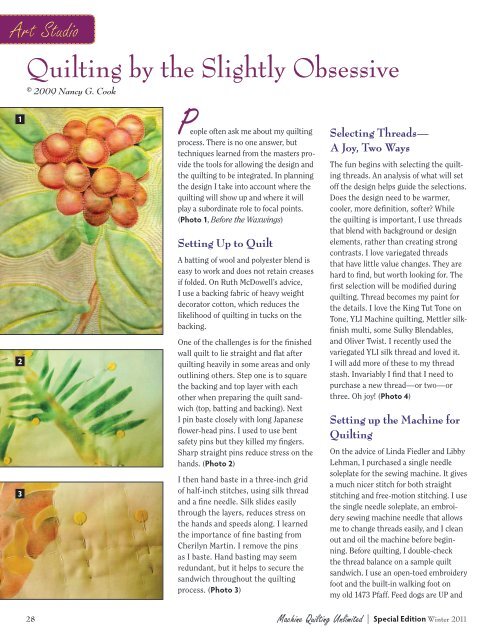Machine Quilting Unlimited - Special Edition - Winter 2011
Machine Quilting Unlimited - Special Edition - Winter 2011
Machine Quilting Unlimited - Special Edition - Winter 2011
Create successful ePaper yourself
Turn your PDF publications into a flip-book with our unique Google optimized e-Paper software.
Art Studio<br />
1<br />
2<br />
3<br />
<strong>Quilting</strong> by the Slightly Obsessive<br />
© 2009 Nancy G. Cook<br />
People often ask me about my quilting<br />
process. There is no one answer, but<br />
techniques learned from the masters provide<br />
the tools for allowing the design and<br />
the quilting to be integrated. In planning<br />
the design I take into account where the<br />
quilting will show up and where it will<br />
play a subordinate role to focal points.<br />
(Photo 1, Before the Waxwings)<br />
Setting Up to Quilt<br />
A batting of wool and polyester blend is<br />
easy to work and does not retain creases<br />
if folded. On Ruth McDowell’s advice,<br />
I use a backing fabric of heavy weight<br />
decorator cotton, which reduces the<br />
likelihood of quilting in tucks on the<br />
backing.<br />
One of the challenges is for the finished<br />
wall quilt to lie straight and flat after<br />
quilting heavily in some areas and only<br />
outlining others. Step one is to square<br />
the backing and top layer with each<br />
other when preparing the quilt sandwich<br />
(top, batting and backing). Next<br />
I pin baste closely with long Japanese<br />
flower-head pins. I used to use bent<br />
safety pins but they killed my fingers.<br />
Sharp straight pins reduce stress on the<br />
hands. (Photo 2)<br />
I then hand baste in a three-inch grid<br />
of half-inch stitches, using silk thread<br />
and a fine needle. Silk slides easily<br />
through the layers, reduces stress on<br />
the hands and speeds along. I learned<br />
the importance of fine basting from<br />
Cherilyn Martin. I remove the pins<br />
as I baste. Hand basting may seem<br />
redundant, but it helps to secure the<br />
sandwich throughout the quilting<br />
process. (Photo 3)<br />
Selecting Threads—<br />
A Joy, Two Ways<br />
The fun begins with selecting the quilting<br />
threads. An analysis of what will set<br />
off the design helps guide the selections.<br />
Does the design need to be warmer,<br />
cooler, more definition, softer? While<br />
the quilting is important, I use threads<br />
that blend with background or design<br />
elements, rather than creating strong<br />
contrasts. I love variegated threads<br />
that have little value changes. They are<br />
hard to find, but worth looking for. The<br />
first selection will be modified during<br />
quilting. Thread becomes my paint for<br />
the details. I love the King Tut Tone on<br />
Tone, YLI <strong>Machine</strong> quilting, Mettler silkfinish<br />
multi, some Sulky Blendables,<br />
and Oliver Twist. I recently used the<br />
variegated YLI silk thread and loved it.<br />
I will add more of these to my thread<br />
stash. Invariably I find that I need to<br />
purchase a new thread—or two—or<br />
three. Oh joy! (Photo 4)<br />
Setting up the <strong>Machine</strong> for<br />
<strong>Quilting</strong><br />
On the advice of Linda Fiedler and Libby<br />
Lehman, I purchased a single needle<br />
soleplate for the sewing machine. It gives<br />
a much nicer stitch for both straight<br />
stitching and free-motion stitching. I use<br />
the single needle soleplate, an embroidery<br />
sewing machine needle that allows<br />
me to change threads easily, and I clean<br />
out and oil the machine before beginning.<br />
Before quilting, I double-check<br />
the thread balance on a sample quilt<br />
sandwich. I use an open-toed embroidery<br />
foot and the built-in walking foot on<br />
my old 1473 Pfaff. Feed dogs are UP and<br />
28 <strong>Machine</strong> <strong>Quilting</strong> <strong>Unlimited</strong> | <strong>Special</strong> <strong>Edition</strong> <strong>Winter</strong> <strong>2011</strong>


